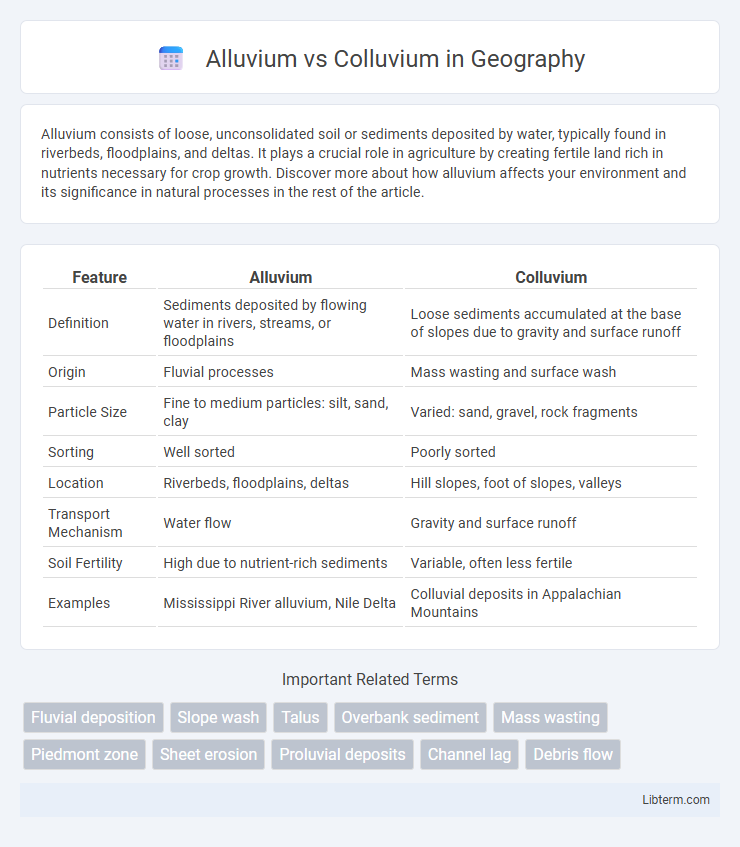Alluvium consists of loose, unconsolidated soil or sediments deposited by water, typically found in riverbeds, floodplains, and deltas. It plays a crucial role in agriculture by creating fertile land rich in nutrients necessary for crop growth. Discover more about how alluvium affects your environment and its significance in natural processes in the rest of the article.
Table of Comparison
| Feature | Alluvium | Colluvium |
|---|---|---|
| Definition | Sediments deposited by flowing water in rivers, streams, or floodplains | Loose sediments accumulated at the base of slopes due to gravity and surface runoff |
| Origin | Fluvial processes | Mass wasting and surface wash |
| Particle Size | Fine to medium particles: silt, sand, clay | Varied: sand, gravel, rock fragments |
| Sorting | Well sorted | Poorly sorted |
| Location | Riverbeds, floodplains, deltas | Hill slopes, foot of slopes, valleys |
| Transport Mechanism | Water flow | Gravity and surface runoff |
| Soil Fertility | High due to nutrient-rich sediments | Variable, often less fertile |
| Examples | Mississippi River alluvium, Nile Delta | Colluvial deposits in Appalachian Mountains |
Introduction to Alluvium and Colluvium
Alluvium consists of loose, unconsolidated soil or sediments deposited by running water, typically found in riverbeds, floodplains, and deltas, characterized by fine particles such as silt, sand, clay, and gravel. Colluvium refers to the accumulation of soil and rock fragments deposited at the base of slopes through gravity-driven processes like landslides, creep, or sheet wash, often containing angular and coarser materials. Both alluvium and colluvium play crucial roles in landscape formation, soil fertility, and sediment transport in different geomorphological settings.
Definition of Alluvium
Alluvium is sediment composed of clay, silt, sand, or gravel deposited by flowing water, typically found in riverbeds, floodplains, and deltas. It is characterized by well-sorted, stratified layers that reflect the transport and settling process of riverine systems. Colluvium, in contrast, consists of loose, unsorted material accumulated at the base of slopes through gravity-driven processes like landslides or sheet erosion.
Definition of Colluvium
Colluvium refers to loose, unconsolidated sediment that accumulates at the base of hillslopes through gravity-driven processes such as soil creep, landslides, or sheet wash, often consisting of a mixture of rock fragments and finer particles. It contrasts with alluvium, which is sediment deposited by flowing water in riverbeds, floodplains, and deltas. Understanding colluvium's role in landscape development and slope stability is crucial for geological studies and land use planning.
Key Differences: Alluvium vs Colluvium
Alluvium consists of fine sediments such as silt, sand, and clay deposited by flowing water in riverbeds and floodplains, whereas colluvium comprises unsorted, coarse debris like rocks and soil accumulated at the base of slopes mainly through gravity. Alluvium is typically well-sorted and stratified due to water transport, while colluvium is poorly sorted and unstratified because it results from mass wasting processes. The deposition environment distinguishes alluvium's association with active waterways, contrasting with colluvium's formation in slope or hillside areas.
Formation Processes
Alluvium forms through sediment deposition by flowing water in rivers and streams, creating layers of silt, sand, clay, and gravel. Colluvium accumulates on slopes due to gravity-driven processes such as soil creep, landslides, and rockfall, containing a mix of weathered rock fragments and soil. The difference in formation processes influences their distribution, texture, and potential use in agriculture and construction.
Physical Characteristics
Alluvium consists of sorted, fine to medium-sized particles like sand, silt, and clay deposited by flowing water, exhibiting a stratified and well-rounded texture. Colluvium is composed of unsorted, angular rock fragments and soil accumulated through gravity-driven processes such as landslides and soil creep, often showing a chaotic, mixed texture. Both materials influence soil fertility and stability but differ significantly in particle size distribution and depositional environment.
Depositional Environments
Alluvium is typically deposited by flowing water in riverbeds, floodplains, and deltas, characterized by well-sorted and stratified sediments such as sand, silt, and gravel. Colluvium accumulates through gravity-driven processes like landslides or sheetwash at the base of slopes, often containing poorly sorted, angular materials including rock fragments and soil debris. Understanding these depositional environments is crucial for applications in soil science, sedimentology, and landscape evolution modeling.
Soil Fertility and Agriculture
Alluvium, deposited by rivers, consists of nutrient-rich, fine sediments ideal for high soil fertility supporting robust crop growth and diverse agriculture. Colluvium, formed by gravity-driven movement of soil and rock downslope, often contains mixed materials with variable fertility but may require soil amendments for optimal agricultural use. Farmers prioritize alluvial soils for sustained yields due to their natural moisture retention and abundant mineral content.
Geomorphological Significance
Alluvium consists of sediments deposited by flowing water, typically found in riverbeds, floodplains, and deltas, playing a critical role in shaping fluvial landscapes and fertile agricultural lands. Colluvium comprises loose, heterogeneous materials accumulated at the base of slopes due to gravity-driven processes like landslides and soil creep, influencing slope stability and erosion patterns. Both alluvium and colluvium are essential in geomorphology for understanding sediment transport, landscape evolution, and hazard assessment in diverse terrestrial environments.
Applications in Engineering and Geology
Alluvium consists of loose, unconsolidated sediments deposited by rivers, commonly used in construction for foundations and groundwater studies due to its high permeability and sediment sorting. Colluvium, formed through gravity-driven processes, features a mix of soil and rock fragments on slopes, posing challenges in slope stability and requiring detailed geotechnical analysis for landslide risk assessment. Engineers and geologists prioritize alluvium for interpretations of sediment transport and aquifer development, while colluvium informs erosion control and hill slope reinforcement strategies.
Alluvium Infographic

 libterm.com
libterm.com